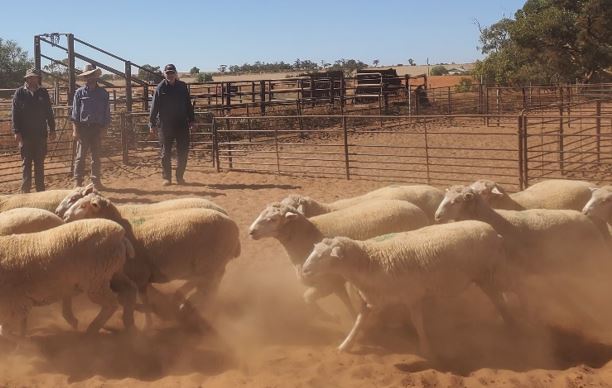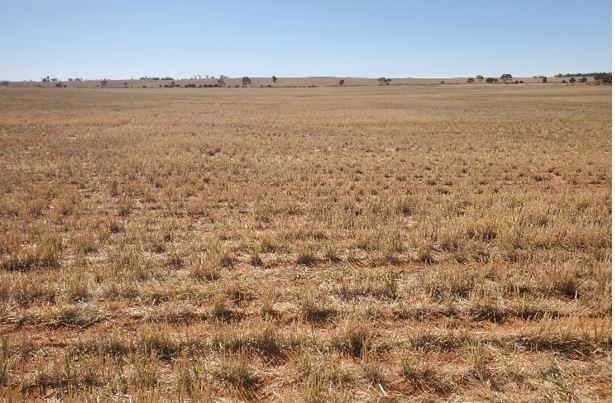Using stock containment to preserve ground cover
Background
During 2019, Werrrimull in the Millewa region west of Mildura, had above average temperatures and recorded just 90 mm of rain, breaking the previous lowest record set in 1982. These conditions followed a few years of very low rainfall so many farmers experienced back-to-back failed harvests and difficulties managing livestock.
This area is made up of soils that are highly or moderately susceptible to wind erosion, which can affect up to 97 per cent of the dryland cropping in this region.
Paddocks with less than 50 per cent groundcover are at a higher risk of soil loss. High levels of wind erosion occurred in this region in 2019, with dust storms being common throughout the area over the 2019 to 2020 summer period.
Throughout the dry seasonal conditions Agriculture Victoria worked closely with farmers to promote land management practices for preserving ground cover and efficiencies with water use. Incentive funding was provided for eligible livestock and cropping enterprises.
A key method for livestock farming is the use of stock containment areas (SCAs) or pens to reduce stock pressure on erosion-prone paddocks during the warmer and drier summer season.
Dale Ramsey, a sheep and crop producer from Werrimull, was already well-versed in using stock containment areas as he grew up on a low rainfall property on the Eyre Peninsula of South Australia where his father had used SCAs since 2000. He has co-farmed on his father-in-law’s property at Werrimull since 2014.
Dale has refined his Werrimull stock containment system for ease of management and for a boost to their farm business. During the lengthy dry seasonal and drought conditions Dale built more pens and increased the size of existing pens.
Family business
Family company farm run by Michael Callahan and sons-in-law Dale Ramsey and Trent Walker. Aiming to spread the risk through the dry years they are in transition from a cropping business to a half sheep and half cropping operation.
Location and landscape
Werrimull, southwest of Mildura, in the Mallee Catchment Management Area.
Property size, soils and rainfall
3200 hectares. Sandy loams on undulating plains and lower slopes of ridges; sandy soils on dunes; with light clays on lower plains.
Rainfall annual average of 250 mm in good years (only 90 mm in 2019, and low in previous years with above average rainfall in 2020).
Enterprises
Sheep: The current emphasis is on building the breeding ewes. At June 2021, there are 1300 Merino ewes, 60% have been joined to Merino and 30% to White Suffolk. Currently on hand there are 700 lambs, 120 will be retained as ewe lambs. Lambing is in early autumn.
Cropping: 1500 ha cereal crops and 1500 ha legume and pastures. Average harvest is barley (1.2 t/ha), wheat (1.0 t/ha), vetch (200 kg/ha) and peas (500 kg/ha).
Set-up
Their SCAs and yards are on the driveway close to the house for ease of monitoring. Pens have capacity for up to 400 sheep.
Stock water is sourced from the Murray Pipeline. There is a 100,000-litre storage tank they can switch to if there is a problem in supply from the pipeline.
While they have large concrete water troughs in the pens, they are also using ‘horse troughs’ that hold 30 litres. Dale said the smaller troughs work well resulting in less spill and mud around the base, and they are much easier to clean.

A long feeding trough has also made a big difference. They constructed it themselves. Dale said, 'the long feeder troughs are the key to making the SCAs work – that way they’ve all got a space to feed at the same time'.
By comparison, the conventional portable feeders can only handle a limited number of sheep at the same time. Dale has found with large stock numbers these feeders can result in issues with crowding and crushing.
Last harvest, the ewes were divided into pens of 400 and it took 9 to10 hours per week to manage them. The tasks included: loading the feed mixer, allowing for mixing time, cleaning the water troughs and filling the feed troughs. Overall, a lot of time is saved using SCAs instead of driving around the large farm feeding sheep.
Feed is a total mixed ration containing grain and straw, fed out on Monday, Wednesday and Friday. The family purchased a feed mixer for $45,000, which Dale said has already proved 'a valuable investment' in terms of labour saving. It is also a much lower outlay than the cost of cropping machinery.
Providing shade and shelter for stock is a crucial management factor for SCAs. Dale said some of the pens have existing trees, which require guarding to protect. In the pens without trees they have cut old water tanks in half. 'We are also testing the use of shade sails across the corners of some pens,' he said.
Benefits to ground cover
Dale is aiming to preserve ground cover, so crop stubbles are not grazed after harvest and the sheep are in containment from November through to early March.
He has sound reasons behind his cautious plan. 'We got hurt with wind erosion in 2018/19 because we did traditional stubble grazing and let the sheep out onto the crop stubble during summer. With the drought conditions the topsoil blew, and those paddocks did not recover.
'If we had used the SCAs we may not have had that problem. We paid for that for two years, because we lost ground cover and our soil tests showed low organic matter.
'We had some paddocks that weren’t grazed which still had straw stubble and they held up really well. You couldn’t really tell they had been through a drought, compared to the ones that had the sheep in them.
'So, this year (2021) we are working to preserve all cover and build organic matter. We could be a little bit conservative by keeping the sheep in the SCAs for longer, but it’s easy to be complacent and assume we will get a crop in the winter for cover, when we know it can easily fail.'
Fortunately, the 2020 winter had above average rainfall allowing some pastures to be sown to vetch, leaving good stubble cover through early summer. Even so, Dale remained reluctant to let the sheep out of the SCAs early, not wanting to run the risk of again losing ground cover and soil during dry conditions.
Dale said the key to using SCAs to protect ground cover is ensuring 'you have enough pens to lock up the sheep so you can stick to your plan'.

Benefits to livestock business
The dry seasons and drought years have meant a loss of income from crops and Dale’s family have been 'looking to get more income from sheep'. With a focus on prime lambs from White Suffolk cross rams over Merino ewes, the sheep are bringing in close to the previous income from crops.
Dale is planning to further increase profits from sheep by increasing the number of self-replacing Merino ewes.
'This winter we could certainly have had more sheep. We can do that with SCAs, because we don’t need to work to the minimum number we can carry through summer, instead working to the maximum number we can carry through winter', he said.
During the busy crop harvest time the SCAs allow for easier management of the sheep. Dale has joined them in SCAs over harvest in October/November.
He said it is also easier to monitor their health. 'With the SCAs being near the house, and the driveway, we can quickly check if there are any issues.'
While they have not experienced any alarming stock health issues associated with the use of SCAs, one problem that did arise was a vitamin E deficiency due to a lack of green feed. Dale said the deficiency is rectified by a simple Vitamin E supplement injection.
Overall, Dale sees the SCAs 'as another tool which is nice to have up your sleeve'. He said the few other locals with pens are using them to finish prime lambs, whereas Dale is using them to protect ground cover and potentially run more ewes.
Next steps
Dale said his biggest management issue is efficient lambing, and questions whether it is possible to safely lamb within SCAs. He said he has been told by other producers, not to lamb in the SCAs 'as it will turn out a disaster'.
For next lambing Dale is considering fencing off a corner of a paddock, an area of around five to ten hectares with tree shelter, for ease of monitoring and to protect soil on the rest of the farm.
Dale said until they can integrate lambing with their use of SCAs it will place restrictions on an expansion of their sheep enterprise.
He has attended numerous valuable sessions run by Agriculture Victoria on SCAs and other farm improvement trials. The next thing Dale would like to see is 'research on lambing systems that can be tied in with a SCA system'.
Ground cover monitoring study
Agriculture Victoria, supported by the Mallee Catchment Management Authority, is monitoring wind erosion risk in the Mallee by assessing groundcover and land management throughout the year.
The project started in 2019 and aims to link the underlying conditions, such as the soil type and wind erosion risk, with the data collected on seasonal conditions, crop cover/groundcover and land management practices.
Data shows 2020 was an average to above average season with the region receiving between 255 mm and 295 mm of rainfall for the year.
The study highlights the change in groundcover in the high and moderate wind erosion-susceptible areas in the Millewa land system throughout 2019 and 2020. Both years have groundcover peaks in late winter when the winter crop growth is at its highest.
The aim for farmers is to maintain as much of this cover as possible after harvest, grazing or hay-cutting activities as summer approaches.
The lower number of bare paddocks and the higher percentage of area protected by groundcover in 2020 should result in less soil movement over summer and autumn for the Millewa and Mildura region.
With three seasons left of the project it will be interesting to see how the cover, management practices and climate relationship impacts erosion across the Mallee.
Further information
For more information on managing during drought and dry seasonal conditions or about the monitoring study, visit Managing for and during drought, contact your local Agriculture Victoria officer or call the Customer Service Centre on 136 186.